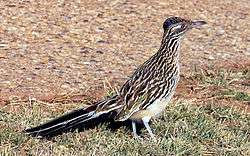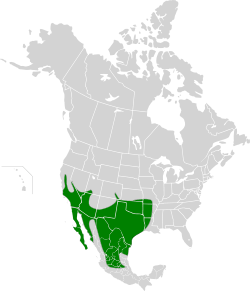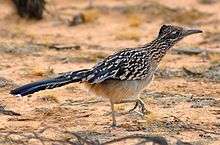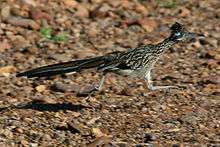Greater roadrunner
| Greater roadrunner | |
|---|---|
 | |
| Scientific classification | |
| Kingdom: | Animalia |
| Phylum: | Chordata |
| Class: | Aves |
| Order: | Cuculiformes |
| Family: | Cuculidae |
| Subfamily: | Neomorphinae |
| Genus: | Geococcyx |
| Species: | G. californianus |
| Binomial name | |
| Geococcyx californianus | |
 | |
| Range of G. californianus | |
The greater roadrunner (Geococcyx californianus) is a long-legged bird in the cuckoo family, Cuculidae, from Southwestern United States and Mexico. The Latin name means "Californian earth-cuckoo". Along with the lesser roadrunner, it is one of two species in the roadrunner genus Geococcyx. This roadrunner is also known as the chaparral cock, ground cuckoo, and snake killer.[3]
Description and morphology
The roadrunner is about 52–62 cm (20–24 in) long, has a 43–61 cm (17–24 in) wingspan and weighs 221–538 g (7.8–19.0 oz). It stands around 25–30 cm (9.8–11.8 in) tall and is the largest cuckoo of the Americas.[4][5][6] Roadrunners have four toes on each zygodactyl foot; two face forward, and two face backward. The toes are brown in color and have pale gold spots. The upper body is mostly brown with black streaks and sometimes pink spots. The neck and upper breast are white or pale brown with dark brown streaks, and the belly is white. A crest of brown feathers sticks up on the head, and a bare patch of orange and blue skin lies behind each eye;[7] the blue is replaced by white in adult males (except the blue adjacent to the eye), and the orange (to the rear) is often hidden by feathers.[3]

Although capable of limited flight, it spends most of its time on the ground, and can run at speeds up to 32 km/h (20 mph).[7] Cases where roadrunners have run as fast as 42 km/h (26 mph) have been reported.[8] This is the fastest running speed clocked for a flying bird, but not nearly as fast as the 70 km/h (40 mph) of the flightless and much larger ostrich.[9]
Distribution and habitat
The greater roadrunner is found in the southwestern United States and northern Mexico. It can be seen regularly in the US states of California, Arizona, New Mexico, Texas, Nevada, Utah, Colorado, and Oklahoma, and less frequently in Kansas, Louisiana, Arkansas, and Missouri,[3] as well as the Mexican states of Baja California, Baja California Sur, Sonora, Sinaloa, Chihuahua, Durango, Jalisco, Coahuila, Zacatecas, Aguascalientes, Guanajuato, Michoacán, Querétaro, México, Puebla, Nuevo León, Tamaulipas, and San Luis Potosí.[10] The species is not migratory.
The greater roadrunner can be found from 60 m (200 ft) below sea level to 2,300 m (7,500 ft) (rarely up to 3,000 m (9,800 ft)). It occupies arid and semiarid scrubland, with scattered vegetation (typically less than 50% cover) with a height of less than 2–3 m (6.6–9.8 ft).[3]
Behavior

The greater roadrunner nests on a platform of sticks low in a cactus or a bush and lays three to six eggs, which hatch in 20 days. The chicks fledge in another 18 days. Pairs may occasionally rear a second brood.
This bird walks around rapidly, running down prey. It feeds mainly on small animals including insects, spiders (including black widows), tarantulas, scorpions, mice, small birds, and especially lizards and small snakes. Venomous serpents, including small rattlesnakes, are readily consumed.[11] It kills prey by holding the victim in its bill and slamming it repeatedly against the ground.
The greater roadrunner is monogamous, forming long-term pair bonds. Both birds build the nest, with the male collecting the material and the female constructing the nest. Nest building starts in March in Texas, and probably later further north. The nests are compact platforms of thorny branches lined with grasses, feathers, snakeskin, roots, and other fine material.[3]
Cultural references
Some Pueblo Native American tribes, including the Hopi, believed the roadrunner provided protection against evil spirits. In Mexico, some said it brought babies, as the white stork was said to in Europe. Some Anglo frontier people believed roadrunners led lost people to trails.[3]
Wile E. Coyote and the Road Runner are the two protagonists of a long-running (since 1949) Warner Bros. cartoon series.
The roadrunner appeared in a 1982 sheet of 20-cent United States stamps showing 50 state birds and flowers, being the state bird of New Mexico.[12]

References
- ↑ BirdLife International (2012). "Geococcyx californianus". IUCN Red List of Threatened Species. Version 2013.2. International Union for Conservation of Nature. Retrieved 26 November 2013.
- ↑ "Geococcyx californianus (Lesson, 1829)". Integrated Taxonomic Information System. Retrieved 9 February 2006.
- 1 2 3 4 5 6 Hughes, Janice M. (1996). Poole, A, ed. "Greater Roadrunner (Geococcyx californianus)". The Birds of North America Online. Ithaca: Cornell Lab of Ornithology. doi:10.2173/bna.244. Retrieved 28 May 2010. (Subscription required.)
- ↑ "Greater Roadrunner". All About Birds. Cornell Lab of Ornithology.
- ↑ "Greater Roadrunner". 2011.
- ↑ "New Mexico State Bird". 2015.
- 1 2 Lockwood, Mark W. (2007). Basic Texas Birds: A Field Guide. University of Texas Press. p. 168. ISBN 978-0-292-71349-9.
- ↑ Wood, Gerald (1983). The Guinness Book of Animal Facts and Feats. ISBN 978-0-85112-235-9.
- ↑ "SPEED OF ANIMALS, ROADRUNNER, Geococcyx californianus". Retrieved 2017-04-09.
- ↑ Howell, Steve N. G.; Webb, Sophie (1995). A Guide to the Birds of Mexico and Northern Central America. Oxford University Press. p. 350. ISBN 0-19-854012-4.
- ↑ Cornett, James W. (2001). The Roadrunner. Palm Springs, California: Nature Trails Press. ISBN 0-937794-31-7.
- ↑ "1982 USA Stamps".
Further reading
Hoese, William; Anticona, Steve; Olmos, Erik; Parent, John; Rutti, Donald; Velasco, Beth (March 2013). "Greater Roadrunner (Geococcyx californianus) Kills Juvenile Desert Cottontail (Sylvilagus audubonii)". Southwestern Naturalist. 58 (1): 124–126. doi:10.1894/0038-4909-58.1.124.
External links
| Wikimedia Commons has media related to Greater roadrunner. |
| Wikispecies has information related to Geococcyx californianus |
- Greater Roadrunner - Geococyx californianus at Animal Diversity Web
- The Roadrunner at DesertUSA.com
- Greater Roadrunner Species Account – Cornell Lab of Ornithology
- Greater Roadrunner FieldGuide at eNature.com
- Greater Roadrunner at NatureWorks
- "Greater roadrunner media". Internet Bird Collection.
- Greater roadrunner photo gallery at VIREO (Drexel University)
